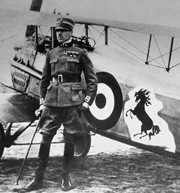E-Archive
Off the Beaten Track
in Vol. 11 - November Issue - Year 2010
A Small Rampant Horse

Francesco Baracca with his Spad XIII
The buzz of its engine could be heard long before the fighter plane came into view. The biplane had been strafing enemy lines since the break of day on that warm June morning in 1918. On the plane’s fifth run, a bullet shot from a rifle on the ground smashed through the engine and the flying machine immediately burst into flames, nose-diving on a hill at the foot of the Alps in Northeastern Italy. The impact was tremendous and there was no escape for the pilot.
******
Reconstruction in Europe in the years immediately following the First World War spawned incredible growth in construction and in the industries in general. In particular, mechanical industries started moving from highly labor-intensive production methods to much more efficient means, thanks to the development of new types of machines and equipment. The automotive sector benefited enormously from these developments, with new automobile factories and brands springing up everywhere. Automobile races were organized all around the continent, both on the road and on the first specially-built race tracks.
One of the first successful automobile race pilots was a young man born in Modena in the year 1898. At the age of sixteen, he had been hired as a junior correspondent with a sports newspaper, a job he had to leave when he was drafted into military service at the break of World War I. After the war, he was hired as a worker in a small mechanical plant in 1919, where he quickly developed a strong interest for machines, motors and automobiles. Later that same year, he took part in an automobile race on a city circuit, with very negative results. Notwithstanding this initial disappointment, he dedicated every free minute he had to what had become his burning passion: race cars. He soon joined a racing team, where he helped to develop faster and more powerful race cars, which he always insisted on testing himself.
His persistence paid off and he achieved his first victory in June 1923, on a suburban circuit covering a distance of 267 kilometers. Among the spectators watching that race were the parents of the air force fighter pilot killed in action five years earlier. The elderly couple was impressed with the young race pilot’s courage and determination, which reminded them so much of the qualities of the son whom they had lost. When the couple met him a few months later, the fighter pilot’s mother approached the race driver and gave him the emblem which had appeared on her son’s fighter plane. It was the figure of a black horse, rearing on its hind legs. “Please, sir, take this emblem and place it on your automobile,” she said to the astonished young man, “it will bring you good luck.” The race car driver accepted the gift out of respect for the woman’s grief, but he relegated the drawing to the bottom of a drawer, where it lay forgotten for years.
The young man went on to win race after race, until he was asked to organize a team of drivers which included many of the most famous names in that period and which dominated the racing scene for many years. He retired from active racing in 1931 and dedicated himself to the management of his team and to the development of race cars. When he got around to choosing a logo to reinforce his team’s identity, he remembered the drawing of the horse which he had received years earlier and he promptly put it on the flank of his cars, where the small rampant horse first appeared in 1932.
Two young men who never met each other, born ten years apart and whose destinies crossed many years later. The first, a fighter pilot named Francesco Baracca, who died at the age of thirty during the war. The second, a race car driver named Enzo Ferrari who went on to set up his own automobile factory and who lived until the ripe old age of ninety. To this day, the factory continues to manufacture sports cars and race cars which are at top of their category and which are famous the world over. Each and every one of these cars proudly displays a small rampant horse.
By Giovanni Gregorat, Contributing Editor MFN & Sales Manager, Pometon Abrasives
Author: Giovanni Gregorat



























